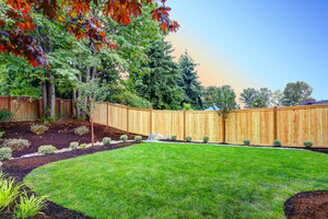Wood fence installation Markham, ON
Even with the introduction of newer materials for privacy fencing, wood fencing remains popular in homes, businesses and other settings. Residential wood fencing integrates well in the vast majority of neighbourhoods, simply due to the fact that you’re using a natural material that blends well with the outdoors and natural environment and that they come in a variety of styles. You’re likely used to seeing the vertical board fence, but depending on your style and location of wood fence installation, you can consider styles like: louver (horizontal boards), lattice (criss cross style), post and rail (popular in gardens and farms), and the classic wood picket style (usually 4 feet high with pointy tip pickets and popular in gardens, front yards and as a pool enclosure).
Wood has general shared features such as its small environmental footprint, its wide array of customization options, its natural beauty and its curb appeal which may increase a property’s return on investment (or ROI). However, there are some stark differences between different wood species and we’ll dive into that here. The most common woods used in fencing are: pine and cedar. Pine fence:
|
- Withstands soil conditions so typically used as fence posts regardless of which wood species used for the boards.
- The pressure treatment may be off-putting to some due to the chemicals used; it also creates a not so aesthetically appealing green tinge, although the wood can be easily stained to disguise this.
- With regular maintenance, pressure treated pine fencing has a lifespan of around 15 years.
- Maintenance involves regular annual or more frequent inspection of loose nails or rotting boards. The boards should be sealed regularly to maintain its integrity, and painted or re-stained every few years.
Cedar fence:
- Has a pleasant smell and has natural oils and properties that resist insect infestation.
- With proper maintenance, cedar fencing can last an average of 30 years.
- Less likely to warp or rot than pine.
- Requires regular maintenance but not as much as with pine. Should be inspected regularly for loose nails and broken boards and repaired in a timely manner.
- Cleaning is straightforward with mild soapy water and a soft brush or cloth, but pressure washing is also an option.
- May need regular resealing to maintain its reddish brown look, unless a weathered look is preferred.
- Doesn’t fare well in soil conditions so pine posts are typically used instead.
- Has many advantageous features over pine fencing, but upfront cost is considerably higher than pine.
With all wood species, it’s important to do a visual check for branches that are leaning into the boards, or vines and weeds that may be growing on the fence. These should be clipped or trimmed to prevent damage to the boards.
Wood is a good choice for a beautiful, natural, eco-friendly enclosure for your property. We at Markham Fence have skilled and experienced wood fencing contractors who care about the durability and beauty of your enclosure. Markham Fence ensures your fence build will be done to meet or exceed your expectations. Call us for a free estimate and we look forward to working with you.


